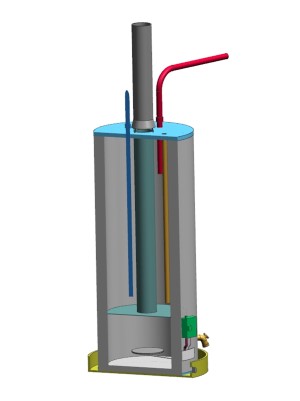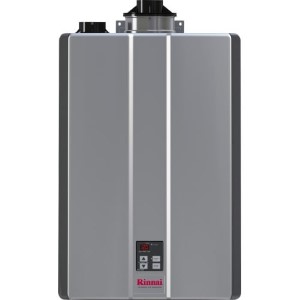- Home
- Gas Water Heaters
- Installing a Gas Water Heater in the Attic
Installing a Gas Water Heater in the Attic: Good or Bad Idea?
Installing a gas water heater in the attic space emerges as a compelling consideration for homeowners aiming to optimize living space or reposition their water heating systems.
This choice, while being the best or the only viable solution for some households, brings with it a unique set of challenges, including issues like pilot light and main burner outages.
Despite its benefits, the decision to proceed with an attic installation necessitates a careful evaluation of both the advantages and potential drawbacks.
 Gas water heater
Gas water heaterThis article endeavors to illuminate these aspects, offering practical tips and alternative solutions to ensure a safe, reliable, and efficiently installed water heating system.
Whether you're looking to save space or address specific installation challenges, understanding the problems and how to solve them is crucial for achieving a proper, trouble-free setup.
Pros of installing a gas water heater in the attic
- Space Saving: One of the most significant benefits of installing a gas water heater in the attic is the conservation of living space. It frees up areas in more commonly used parts of the house, such as basements or utility rooms, which can be particularly advantageous in homes where space is at a premium.
- Energy efficiency improvements: In some cases, relocating the water heater to the attic can lead to energy efficiency improvements, especially if the attic is well-insulated. Heat loss can be minimized, making the system more efficient than in unconditioned spaces like garages or basements.
- Safety and security: Having the water heater in the attic can add an extra layer of safety by keeping it out of reach of children and reducing the risk of accidental tampering or damage.
Cons of installing a gas water heater in the attic
Installation and maintenance challenges: Access to the attic can be more difficult than more traditional locations, making installation and ongoing maintenance potentially more cumbersome and expensive. Special considerations for venting and gas supply lines also need to be addressed, which can add complexity and cost.
Potential for freezing: In colder climates, the risk of the water heater or associated piping freezing increases if the attic is not adequately insulated. This could lead to significant damage and necessitate costly repairs.
Safety concerns: The installation of gas appliances in less accessible areas raises safety concerns, including the risk of gas leaks going undetected. Proper installation and ventilation are crucial to mitigate these risks, along with regular maintenance checks.
Risk of undetected leaks: Water heaters, over time, can develop leaks due to corrosion, faulty connections, or wear and tear. When a water heater is placed in the attic, these leaks can go unnoticed for longer periods, especially if the attic is not regularly visited.
This delay in detection can lead to extensive water damage, affecting the ceiling, walls, and even the structural integrity of the property. The accumulation of water can also promote mold growth, which poses health risks and requires costly remediation efforts.
Therefore, it's crucial to have leak detection systems in place and perform regular inspections to mitigate these risks effectively.
Problems and dangers of installing a gas water heater in the attic
Difficult access: Installing a gas water heater in the attic comes with a specific set of challenges and potential dangers that homeowners should carefully consider. The issues range from practical installation concerns to safety risks that could have serious consequences.
Complex installation: Attics are often hard to access, making installation and routine maintenance challenging and potentially discouraging regular inspections, leading to neglect. Such oversight increases the risk of leaks and malfunctions in gas appliances, which can be hazardous.
The installation process in an attic requires careful planning for venting and gas lines, making it more complex and costly. If not done correctly, this can result in gas leaks and inadequate ventilation, heightening the risk of fire or carbon monoxide poisoning.
Increased risk of leaks and water damage: While placing the water heater in the attic minimizes the risk of water damage to living spaces, leaks can still cause significant damage to ceilings, walls, and belongings stored in the attic. Undetected leaks can lead to mold growth and structural damage over time, posing health risks and potentially requiring costly repairs.
Ventilation concerns: Ensuring adequate ventilation for gas water heaters is critical to safety, and achieving this in an attic is challenging. Poor ventilation can lead to the accumulation of toxic gases such as carbon monoxide, which poses a severe risk to the household's health and safety.
This is particularly challenging for atmospherically vented gas water heaters positioned in attic spaces.
Risk of freezing: In colder climates, the water heater or its pipes could freeze if the attic is not well-insulated, causing pipes to burst and potentially leading to water damage and a need for expensive repairs or replacements.
Difficult emergency shut-off: In the event of a problem, quickly shutting off the water heater is crucial, but an attic installation may make it harder to access the shut-off valves in an emergency. This can exacerbate issues, increasing the risk of damage or danger to the home and its occupants.
Compliance and insurance issues: Lastly, compliance with local codes and insurance policies should not be overlooked when installing a gas water heater in the attic. Failure to adhere to regulations can lead to legal issues, fines, or denied insurance claims, compounding the financial and safety risks of the installation.
Alternatives to attic installation
If the attic installation seems daunting or if the cons outweigh the pros for your situation, consider these alternatives:
Tankless water heaters: Tankless or on-demand water heaters can be a more space-efficient option, as they don't require a large tank and can be installed in more accessible locations, including closets or even on exterior walls.
Basement or garage installation: These traditional locations for water heaters are still viable options, especially if they can be made more efficient with better insulation or updated technology.
Outdoor units: Some gas water heaters are designed for outdoor installation, which can save interior space and reduce concerns about venting and gas leaks inside the home.
Weather conditions, ventilation, and attic heater installation
The attic space must be properly ventilated, especially in the summer, as external temperatures and humidity can soar to high levels. If not adequately ventilated, the attic temperature can reach critical levels, negatively impacting the gas water heater's performance.
The effectiveness of the natural draft in atmospheric-vented gas water heaters depends on a sufficient temperature difference between the exhausted gases and the surrounding air. A minimal temperature difference hampers the heater's ability to draw in fresh air, potentially extinguishing the pilot light and main burner.
Bradford White and other water heater manufacturers recommend ensuring adequate ventilation, using soffit vents in combination with ridge vents or electric fans, to prevent such issues.
Regular inspections are crucial to ensure insulation does not obstruct any vents; if any blockages are found, they should be cleaned promptly.
To check if the attic receives fresh air, conduct a simple test during the day: turn off all lights in the attic and close the door.
If daylight is visible through openings, gaps, and cracks, it indicates some air exchange; however, the absence of daylight suggests ventilation problems.
Conclusion
Installing a gas water heater in the attic can be a smart choice for homeowners looking to save space and maybe even use less energy.
However, because these water heaters are big and bulky, putting them in the attic can be tough and sometimes not the best idea.
It's important to only go this route if you really need to and to make sure the water heater has everything it needs to work well, like enough air, space around it, and a way to catch and alert you to any leaks.
It's also key that you can easily get to parts of the heater that might need fixing or replacing down the line.
By thinking through these points, homeowners can decide if this option is right for them, keeping their home safe and comfortable.
- Home
- Gas Water Heaters
- Installing a Gas Water Heater in the Attic



